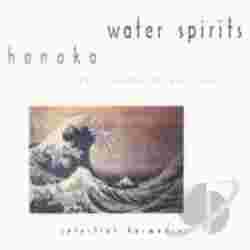The dawning of
Honoka resulted from a period of intense collaboration between koto player
Satsuki Odamura, and composer and
shakuhachi performer
James Ashley Franklin.
In 1989 Satsuki Odamura moved to Australia with a musical mission where she has played a pioneering role in introducing the koto to audiences outside Japan. She has collaborated with a wide range of musicians in a variety of styles including Australia's premiere contemporary percussion ensemble Synergy. As part of her mission, Satsuki is awakening an appreciation of differences between Western and Japanese musical cultures, bridging the gap between them. In particular, she is interested in the appreciation of the ma - the gaps between the notes.
Shakuhachimaster, composer, ethnomusicologist, and lecturer James Ashley Franklin's musical career bridges a wide range of styles, from classical Western music to electronic music, and to traditional and modern music for the shakuhachi. He studied Western art music together with ethnomusicology at the University of Sydney, and trained as a composer in Australia and Europe. His music has won numerous awards worldwide.
After meeting shakuhachi grand master Riley Lee, featured on Shoalhaven Rise (13195-2), whom he later studied with, James discovered a natural affinity between the music he was composing and the music for this ancient flute.
James also teaches, both in Western and in Japanese genres, teaches shakuhachi, and is the Senior Lecturer in Music Technology at the Music Department of the University of Western Sydney, Nepean. He can also be heard on Butsuga (13177-2), Moon Road to Dawn: An Encounter of Chinese and Japanese Traditional Music (13180-2) with Antony Wheeler, and Abundance(13192-2) and Aurora (13236-2) with Michael Atherton.
Water Spirits resulted from the same period of intense collaboration between Satsuki Odamura and James Ashley Franklin as the dawning of Honoka.
The titles of each track, as well as that of the recording itself, reflect the feeling which underlies all the music: the sounds, sights and textures of water, found in different landscapes and manifestations, from streams in the mountains to noble coastlines. These natural images are in tune with the connection with the natural world shared by
shakuhachi and
koto; the electronic sounds have been designed to blend with these textures in a unified, integrated whole.
Mountain Stream and Lonely Headlands were recorded as improvisations, in one recording from start to finish and have not been edited.
Dewdrop Pearls was initially recorded as an improvisation for koto and synthesizer; the koto part was kept intact, but the synthesizer part was discarded and completely recomposed to create the finished piece.
Kirisame - Misty Rain was created as a unified work: the electronic parts were recorded first, but the shakuhachi part was composed simultaneously and subsequently recorded.
New and seasoned koto and shakuhachi music lovers alike will be enchanted with Honoka's expressive depth of these instruments and repertoire of traditional and modern music.

